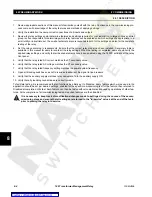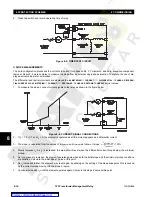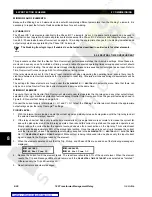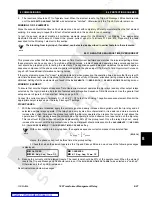
GE Multilin
745 Transformer Management Relay
8-17
8 COMMISSIONING
8.5 PROTECTION SCHEMES
8
8.5.3 INSTANTANEOUS DIFFERENTIAL PROTECTION
Settings for this element are under the
S4 ELEMENTS
ÖØ
INST DIFFERENTIAL
setpoints group. All other protective elements
must be disabled to ensure that trip relay(s) and auxiliary relays are operated by element under test. Monitor the appropri-
ate contact per intended settings of the FlexLogic™.
a) MINIMUM PICKUP
1.
The operating level of the Phase A element is measured by applying an AC current to terminals H1 and G1. Monitor
the appropriate trip and auxiliary contact(s) as the current is increased from 0 A. Due to the auto-configuration feature,
it may be easier to read the actual differential current on the relay rather computing it. Compare the value of the differ-
ential current at which operation is detected against the
S4 ELEMENTS
ÖØ
INST DIFFERENTIAL
ÖØ
INST DIFFERENTIAL
PICKUP
setpoint:
2.
Check that the Trip and Message LEDs are flashing and the following trip message is displayed:
The message may show OPERATED instead of LATCHED if the TARGET setpoint is "Self-Reset".
b) OPERATING TIME
1.
To measure the basic operating time of the instantaneous differential elements, connect an AC current signal to termi-
nals H1 and G1 through a double-pole, single-throw switch. The second pole of the switch starts a timer circuit that will
be stopped by the operation of the relay trip contact. Refer to Figure 8–5: Timer Test Circuit on page 8–14.
2.
Close the switch and set the current level to 2 times the pickup value measured earlier. Re-open the switch and reset
all targets on the relay. Ensure that the timer circuit functions correctly.
3.
Close the switch and record operating time of relay.
All the differential currents are calculated using the same principal used in Section 8.4.4: Transformer
Type Selection on page 8–8. The differential current derivation is affected by phase shift compensation
and zero sequence removal.
c) TARGET, OUTPUT CONTACT, AND DISPLAY OPERATION
Verify the correct operation of all targets and output contacts and display messages during testing.
d) BLOCKING FROM LOGIC INPUTS
Each element is programmable to be blocked by a logic input, virtual input, virtual output, output relay operation, or self-test
relay operation. This test verifies that the differential element can be blocked by Logic Input 1.
1.
Select Logic Input 1 by setting the
S4 ELEMENTS
ÖØ
DIFFERENTIAL
Ö
PERCENT DIFFERENTIAL
ÖØ
PERCENT DIFFEREN-
TIAL BLOCK
setpoint to "Logc Inpt 1".
2.
Apply current to operate the differential element then assert Logic Input 1. Verify that the element has reset and that all
targets can be reset.
3.
With Logic Input 1 asserted, remove the current and reapply. Verify that the element did not operate.
8.5.4 PHASE TIME OVERCURRENT
This procedure verifies that the phase time overcurrent element performance matches the in-service settings. Since these
elements can have any one of a multitude of timing curves, a table of expected operating times versus applied current
should be prepared prior to testing the elements. Refer to Time Overcurrent Curves on page 5–49 for information on timing
curves.
If the relay elements are set for a "Linear" reset characteristic when measuring the operating times, ensure that there is suf-
ficient time between test current injections for the element to reset fully; otherwise, erroneous timing measurements will be
obtained. The settings for these elements are found in the
S4 ELEMENTS
ÖØ
PHASE OC
setpoints page.
LATCHED: a (bc)
Inst Differential
NOTE
NOTE
Содержание TRANSFORMER MANAGEMENT RELAY 745
Страница 2: ...Courtesy of NationalSwitchgear com ...
















































